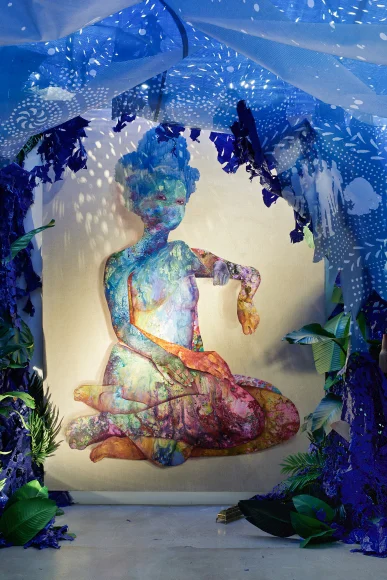How To Gauge A Great Artist: Firelei Báez
Image courtesy the artist and James Cohan, New York.
The first time I saw Firelei Báez’s work was in the Studio Museum’s 2011 Summer/Fall magazine and I was transfixed. From just one image, I was tessered into a hybrid sci-fi/tropical world through a new visual vocabulary of figuration and abstraction, vibrantly textured patterns and luscious feminine beings that were unidentifiable inhabitants of some other universe, yet instinctually familiar women of color. I thought to myself, “She gets me. How did she know?”
Flashback 20-odd years prior, fantasy was my favorite film genre growing up and I have always intensely loved beauty in all forms. In that moment, Firelei’s work delightfully satisfied a whole new intersection of visual culture that stoked feelings of discovery and wonderment, familiarity and the unknown.
Image courtesy the artist and James Cohan, New York.
Throughout her practice, Firelei draws inspiration from reimagining Afrodiasporic figures, ciguapas of Dominican folklore, and other mythological, cultural, and healing Afro-Latina and Afro-Caribbean symbols. And the way her mainly pictorial work continues to evolve creates renewed enchantment with each new series. There are many ways to gauge a great artist and their ability and potential to evolve is one of them.
Image courtesy the artist and James Cohan, New York.
Her debut solo exhibition at James Cohan Gallery in Manhattan is currently on view through June 16. It is spectacular, richly symbolic, and transforms the Lower East Side location into a multisensory cocoon of hand-perforated blue tarp. The structure features interwoven lush green foliage, hidden fans blowing gentle breezes, permeating fragrances of palo santo and Oman incense regarded for their healing and cleansing properties, and dappled light reflected through perforations in draped material patterned after a map of the stars as they appeared in the night sky at the onset of the Haitian Revolution (1791–1804).
Image courtesy the artist and James Cohan, New York.
The protective den swaddled in celestial feminine energy lures you in, literally and figuratively, to learn the deeper diasporic stories of nurturing and resistance that construct the space. Its immersive oceanic quality is suggestive of the broader history of the Middle Passage, and the two enshrined and stunningly painted portraits of fictional Haitian priestesses located on opposite sides – fashioned in tignons, headcoverings women of color were legally required to wear in 18th century New Orleans – honor and reflectively hold space for the women whose revolutionary contributions are absent from heroic retellings.
Firelei is also quite possibly one of the most genuine and gracious artists that I have ever met. She lives the healing that she creates, and you can feel it.
About The Writer:
Jill Smith Handy is a contemporary art consultant based in New York City. She advises private collectors, public arts organizations, corporations, and local communities. Having worked in the art world for over a decade, Jill has held positions at leading post-war and contemporary art organizations such as David Zwirner Gallery and Kim Heirston Art Advisory. She believes that contemporary art can create powerful experiences from improving wellness to driving social change and is passionate about supporting emerging artists.









A Thoughtful Misfit is a woman who doesn't fit in boxes - from how she dresses, to the way she lives, to the way she chooses to mother and to love…